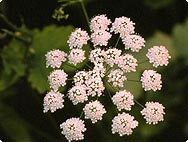A.Vogel search
When the internal search is activated, personal data such as your IP address is transmitted to our search engine Cludo. Data is thus transferred to a third country. Please click here if you want to display the internal search. You can find more information on data protection here: Privacy policy.
A.Vogel plant encyclopaedia
Pimpinella anisum L.
Anise
History

Anise is mentioned as early as the famous Ebers papyrus, written about 1550 B.C. In antiquity, anise was an ingredient in the panacaea ’theriak‘, which Pliny claimed was effective against all diseases and poisonings. Since anise was considered an appetite-stimulator, it was also called aniketon (= the invincible). In his Materia Medica, the Roman military physician Dioscorides called anise “an especially good medication”.
The origin of the Romanic term pimpinella is unknown. The Italian physician Benedictus Crispus made the earliest surviving reference to it in the 7th century. The name was used for a wide variety of plants and it is no longer possible to identify the species referred to.
Down the centuries anise has been very popular. Many liqueurs, such as Ouzo, Raki, Pernod, Pastis, Goldwater or Anisette are testament to this.
Botanical characteristics
Anise is an annual, herbaceous plant growing up to 60cm in height. The lower leaves have a roundish, kidney shape, while the stalk leaves are pinnatifid to tripinnatifid and become more and more finely divided the higher up the stalk they grow. The round, grooved stalks branch in the upper part of the plant and form apical, composite umbels with white blossoms. The grey-green, pear-shaped fruits are thickly covered with hair and consist of two halves with light-coloured ridges. The whole plant smells aromatically of aniseed.
Anise blooms from July to August.
Habitat
It is believed that anise originated in the Mediterranean region and western Asia. Today it is cultivated primarily in southern Europe, the Mediterranean region, the Near East, India, and in the territory of the former Soviet Union. Anise is seldom found growing wild. At harvest-time, the plants are pulled up and after drying, the fruits are threshed and gathered.
Preparation
A.Vogel/Bioforce uses anise oil that is extracted from the ripe fruits by aqueous distillation. In their monographs on Anisi aetheroleum, DAB 10 and the Ph. Helv. VII include star anise oil made from Illicium verum HOOKER. The composition of star anise oil is almost identical to that of anise oil.
The anise fruits are prepared as an infusion, usually after being ground in a mortar. They are also used to manufacture schnapps and liqueurs and as a condiment in baked goods.